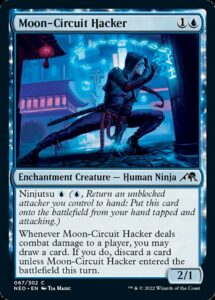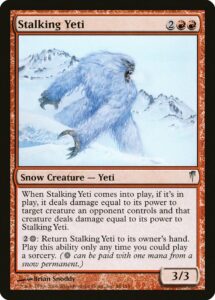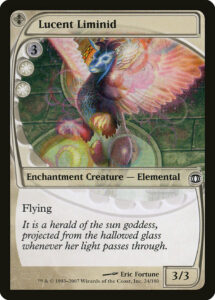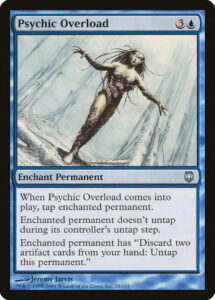Kamigawa: Neon Dynasty is out, and it’s quite the doozy of a Limited format. There’s an incredible amount of design that went into making each of the archetypes both flexible and specific, enabling a slew of mechanics, and reinvigorating one of Magic’s initially worst-performing worlds. However, this wealth of design squeezing so much possibility into each card also means Kamigawa could be Magic’s wordiest set ever.
To engage in this discussion, let’s focus on just one, relatively simple common.
Ninja of the Shallow Hours
Moon-Circuit Hacker is one of blue’s premier commons. It’s a powerful and straightforward effect, calling back to one of Betrayers of Kamigawa’s most notable shinobi, Ninja of the Deep Hours. In many ways, it’s both a stronger and better design. With Ninjutsu for a single blue mana, it’s easier to sneak in a hit and guarantee a card. The fail case of a two mana 2/1 is also far better than that of a four mana 2/2.
Moon-Circuit Hacker is far less potent than Ninja of the Deep Hours on subsequent turns, but that makes for better gameplay. Ninja of the Deep Hours can create a Planeswalker-like subgame where if it’s unanswered, the game ends as you bury your opponent in card advantage. Instead, you now get your moment of triumph as you create a superior Elvish Visionary, then are left behind with a Daring Saboteur. It’s still a very good creature, but its lower value saboteur ability creates a less tense board state and makes you more inclined to trade in combat.
I’m really impressed with this aspect of the design. By having its saboteur ability weaker when not Ninjutsu-ed into play, the card focuses on the joy of a great Ninjutsu trigger. You have one awesome moment and are left with something solid the next turn that you might just be able to reset via ninja shenanigans. It presents a simple quest, while the more experienced player sees the secondary quest of Ninja-ing it onto the battlefield again and again.
Necessary Awkwardness
As much as I love the modulating effects of Moon-Circuit Hacker‘s damage trigger, the wording has to both read and play a bit awkwardly.
It’s rare for a creature that says when I deal combat damage to an opponent, you may draw a card—the answer is almost always going to be yes! In fact, that’s how Acquisition Octopus, a very similar card in the same set, is worded. But here it can’t, because looters in modern Magic are always optional (the gameplay is better). It’s not a problem, just it’s an awkward, unnecessary click in digital Magic.
There’s also a bit of translation required to understand exactly how this ability works. The card presents you with a “may” that connects to an “if” that brings you to an unrelated “unless.” It’s not the hardest puzzle to solve, but you first need to understand how Ninjutsu works (and how it works in conjunction with this ability) to recognize that this “unless” means “if you just Ninja-ed this into play, don’t discard.”
All together, it’s impressive how Wizards combined two abilities into one streamlined design, kept it appropriately powered for a common, and enabled its secret secondary quest. But accomplishing this feat requires a fair bit of Magic-ese that makes the card harder to parse. For an enfranchised player (as most people reading this likely are), the amount of required brain power may be minimal and one can quickly chunk all the relevant details. But for less enfranchised players, this can be a nontrivial cognitive load. And even for enfranchised players, this minor cognitive load can accumulate when a substantial number of commons demand just a bit of brain power. After all, this ability does something fairly unusual for a Magic card—it changes state, rather than toggles off (like Haste or an enters-the-battlefield effect).
I worry about cognitive load a lot in my profession. As a tabletop game designer, you want to ensure that players are spending their brain power making tough but fun decisions. Sure, different games want players to feel different emotions and to present different mental loads, but very few players enjoy feeling overwhelmed by the mental burden of merely maintaining a game state. A common like Moon-Circuit Hacker worries me because it has an immediate translation issue, a fair amount of text, and an unusual state change. By itself, it’s a sweet design. But in a format with many similarly designed cards, there’s a real chance that the cumulative cognitive load ends up too high for too many players.
The Additional Awkwardness
Thus far, we’ve focused exclusively almost exclusively on Moon-Circuit Hacker‘s text box. But there’s more to the card. The type line has two critical details—it’s a ninja and an enchantment. It being a ninja shouldn’t be too surprising given the Ninjutsu, and astute players will recognize that it’s one of the four relevant creature tribes in Neon Dynasty (alongside rogues, samurai, and warriors).
Being an enchantment is more likely to surprise. If you’ve played a Theros set, you’ll recognize the Nyx-field card border as a clear signal of its enchanted nature. If you haven’t, or if you’re looking at the showcase version, the only indicator is hidden on the type line. The art ostensibly clues an observant Vorthos into the ninja’s use of Kami magic, but I missed this detail given the use of neon colors in an urban environment. all of which read as modernity, not tradition (which enchantments represent).
I understand why Moon-Circuit Hacker is an enchantment creature. It’s a way for design to squeeze just a bit more synergy into the card. It allows Moon-Circuit Hacker to support the unnamed Harmony mechanic that rewards players for controlling both artifacts and enchantments (but which isn’t in blue). It’s a piece of complexity that’s hidden from players and taken care of by Arena’s engine.
But understanding why doesn’t convince me that it should be an enchantment creature. It’s an additional detail on a card that already has ample nuance. Looking at the set as a whole, this design approach is widespread and a little baffling. It feels almost random which creatures are enchantments, which are artifacts, and which are neither. This effectively adds another attribute to every creature in the set one needs to track, making it just a little bit harder to keep track of the battlefield.
A lot to take in
My first few drafts of Kamigawa: Neon Dynasty were some of the most mentally-taxing I can remember. I loved the massive possibility space that Modern Horizons 2 provided and have always loved the higher complexity level of Masters sets. I loved optimizing my decisions at Grand Prix and Team Draft League, yet Neon Dynasty felt different. So many of my cards had so much modality and so much text to remember. Part of this was fun—Kamigawa affords some very novel heuristics—but part of this was just unpleasant mental taxation. I had too much to keep track of, and in some games, far too many choices I could make.
There’s a lot to love about Moon-Circuit Hacker, but the fact that its high level of complexity isn’t unusual for a common concerns me. I appreciate Kamigawa’s high skill ceiling and applaud what the design team managed to do with a challenging world. But I’m worried that Wizards may be leaning too hard on Magic Arena to make its Limited formats playable.
I worry that once massive paper events return, Wizards will have replicated core problems from Time Spiral and Lorwyn blocks, where cards had overly long text, sets contained too many mechanics (though nowadays they’re mostly unnamed), and creatures’ type lines hid vital details. I could be wrong, of course—while I doubt that Magic players of today have a substantially higher tolerance for complexity than did Magic players in 2007, Wizards could well have found myriad ways to hide complexity behind lenticular design. We’ll see what happens as Kamigawa Limited evolves and with 2022’s later sets.
And, as always, thanks for reading.
Zachary Barash is a New York City-based game designer and the commissioner of Team Draft League. He designs for Kingdom Death: Monster, has a Game Design MFA from the NYU Game Center, and does freelance game design. When the stars align, he streams Magic (but the stars align way less often than he’d like).





